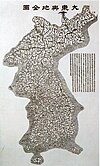
Back حكومة الجيش العسكري الأمريكي في كوريا Arabic Gobiernu militar del Exércitu de los Estaos Xuníos en Corea AST Американско военно правителство в Корея Bulgarian United States Army Military Government in Korea Danish United States Army Military Government in Korea German Gobierno militar del Ejército de los Estados Unidos en Corea Spanish Ameerika Ühendriikide Armee Sõjaväevalitsus Koreas Estonian حکومت نظامی ارتش ایالات متحده آمریکا در کره Persian Gouvernement militaire de l'armée des États-Unis en Corée French המשטר הצבאי של ארצות הברית בקוריאה HE
United States Army Military Government in Korea 재조선 미국 육군사령부 군정청 (Korean) | |||||||||||||
|---|---|---|---|---|---|---|---|---|---|---|---|---|---|
| 1945–1948 | |||||||||||||
| Anthem: "The Star-Spangled Banner" (de jure) | |||||||||||||
 Location of the southern portion of the Korean Peninsula | |||||||||||||
| Status | Military occupational transitional government | ||||||||||||
| Capital and largest city | Seoul | ||||||||||||
| Official languages | Korean, English | ||||||||||||
| US commander-in-chief | |||||||||||||
• 1945–1948 | John R. Hodge | ||||||||||||
| US military governor | |||||||||||||
• 1945 | Archibald V. Arnold | ||||||||||||
• 1945–1947 | Archer L. Lerch | ||||||||||||
• 1947–1948 | William F. Dean | ||||||||||||
• 1948–1949 | Charles G. Helmick | ||||||||||||
| Chairman of assembly | |||||||||||||
• 1946–1948 | Kim Kyu-sik | ||||||||||||
• 1948 | Syngman Rhee | ||||||||||||
| Historical era | Cold War | ||||||||||||
| 15 August 1945 | |||||||||||||
• United States troops stationed | 8 September 1945 | ||||||||||||
| 1 October 1946 | |||||||||||||
| 10 May 1948 | |||||||||||||
| 17 July 1948 | |||||||||||||
| 15 August 1948 | |||||||||||||
| Currency | Won, "A yen" scrip, United States dollar | ||||||||||||
| |||||||||||||
| Today part of | South Korea North Korea | ||||||||||||
| United States Army Military Government in Korea | |
| Hangul | 재조선미국육군사령부군정청 |
|---|---|
| Hanja | 在朝鮮美國陸軍司令部軍政廳 |
| Revised Romanization | Jaejoseon Miyuk-gun Saryeongbu Gunjeongcheong |
| McCune–Reischauer | Chaejosŏn Miyuk-gun Saryŏngbu Kunjŏngch'ŏng |
| History of South Korea |
|---|
 |
|
|
The United States Army Military Government in Korea (USAMGIK) was the official ruling body of the Southern half of the Korean Peninsula from 8 September 1945 to 15 August 1948.
The country during this period was plagued with political and economic chaos, which arose from a variety of causes.[1] The after-effects of the Japanese occupation were still being felt in the occupation zone, as well as in the Soviet zone in the North.[2] Popular discontent stemmed from the United States' military government's support of the Japanese colonial government; then once removed, keeping the former Japanese governors on as advisors; by ignoring, censoring and forcibly disbanding the functional and popular People's Republic of Korea (PRK); and finally by supporting United Nations elections that divided the country. The U.S. administration refused to recognize the Provisional Government of the Republic of Korea, despite the South Korean government considering it their predecessor since 1987.[3][4]
In addition, the U.S. military was largely unprepared for the challenge of administering the country, arriving with no knowledge of the language or political situation.[5] Thus, many of their policies had unintended destabilizing effects. Waves of refugees from North Korea (estimated at 400,000)[6] and returnees from abroad caused further turmoil.[7]
- ^ Chang, Kornel (2020). "Independence without Liberation: Democratization as Decolonization Management in U.S.-Occupied Korea, 1945–1948". Journal of American History. 107 (1): 77–106. doi:10.1093/jahist/jaaa009. ISSN 0021-8723.
- ^ Nahm (1996, p. 351); Lee (1984, p. 375) [title missing]
- ^ Hart-Landsberg, Martin (1998). Korea: Division, Reunification, & U.S. Foreign Policy. Monthly Review Press. pp. 63–67, 70–77.
- ^ Refugees, United Nations High Commissioner for. "Constitution of the Republic of Korea". Refworld. Retrieved 25 May 2023.
- ^ Nahm (1996, p. 340) [title missing]
- ^ Allan R. Millet, The War for Korea: 1945–1950 (2005) P. 59
- ^ Lee (1984, p. 375) [title missing]


